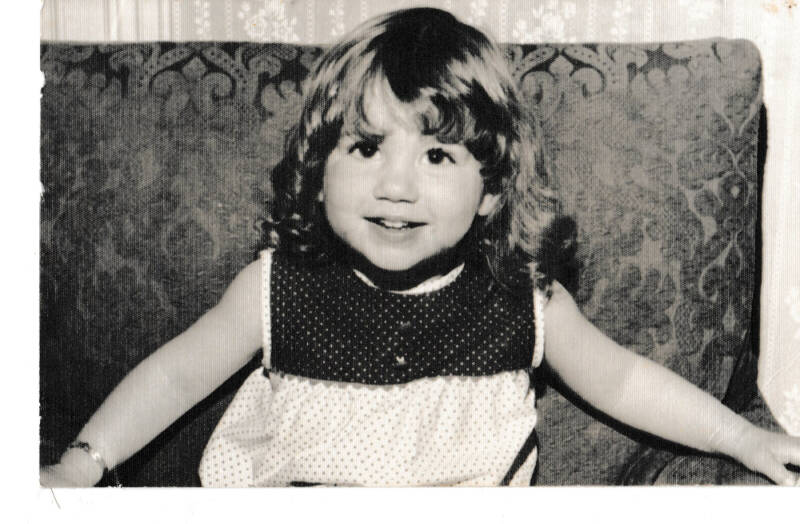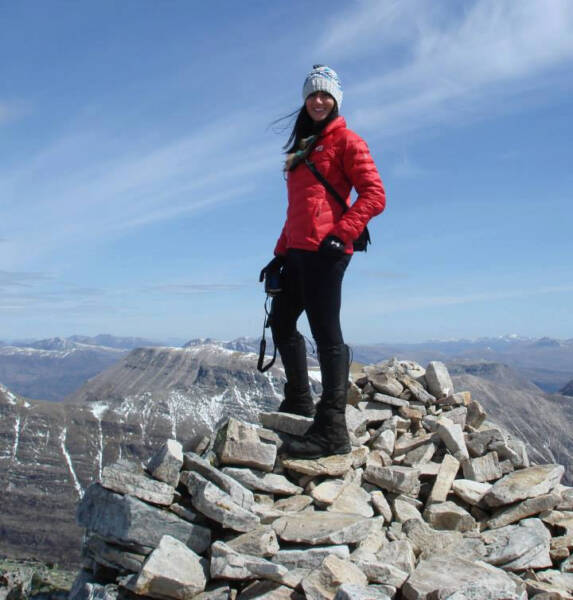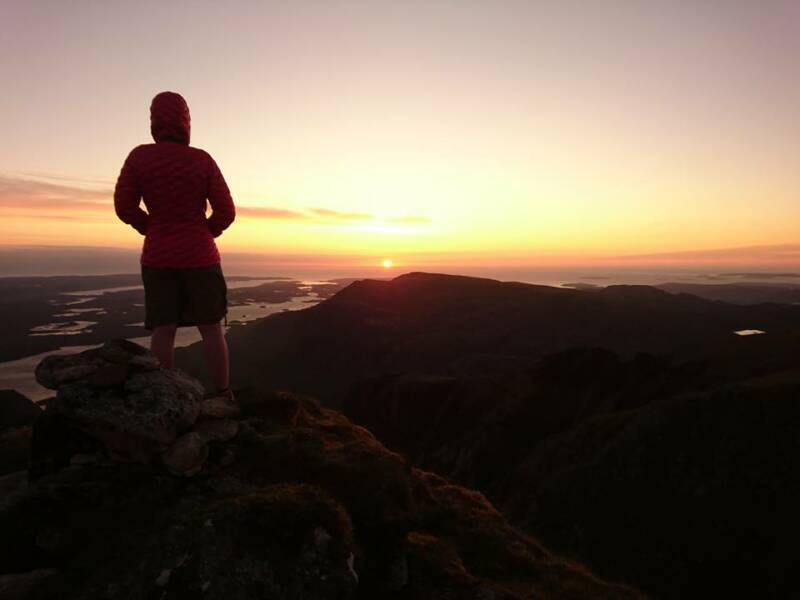
In 1997, at the age of 24, Sarah Jane Douglas lost her mother to breast cancer. Alone and adrift in the world, she very nearly gave up hope, but she’d made a promise to her mother that she would keep going no matter what. So she turned to the beautiful, dangerous, forbidding mountains of her native Scotland. Her book Just Another Mountain was shortlisted for the Edward Stanford Travel Writing Award last year, and it was a Waterstones Book of the Month.
‘Which is your favourite mountain?’ is a question I’m frequently asked, but there are so many of outstanding character I’ve always struggled to answer – and that answer will often change. For me, it’s not just about the aesthetics of a mountain, it’s about the relationship with them how they make me feel.
So I’ll usually recount the first memory I have of feeling a fascination with high places. It occurred when I was no more than 3 years old. I’d climbed out onto the roof of our 3 storey (in other words, pretty bloody high) family home and was sitting out on the slates. I was completely stuck, but wholly intrigued by the snowy (Strathfarrar) hills I could see distantly across the water of the inner Moray Firth.

I wanted to go to all that snow. I went unnoticed on my high perch for quite some time before the alarm was raised by the coalman when he drew up in his wagon. He just happened to look up and see me. My gran was hanging washing on the line and, being Liverpudlian, struggled with the man’s Doric as he tried to let her know there was a ‘bairn’ on the roof . . . ‘Yes, it’s a lovely day,’ she’d answered. She eventually caught his drift when she finally followed his finger that was frantically jabbing skywards. Poor Gran. She dropped her basket and raced indoors to fetch my grandad – another lucky coincidence for me that he was not at his work in Cameron Barracks. With a big, extendable ladder propped against the house it was Grandad to the rescue. Those were much simpler times. I hadn’t felt afraid then.

I was 24 when my mum died from breast cancer. Walking was something we had done a lot of together so after her death walking helped me feel close to her though, at first, grief was so raw I felt a strange mix of both disconnection and comfort from the countryside – I felt disconnected from everything. Like my shadow, grief was a constant companion. But it was when my marriage of two years started running into difficulties, the fire in my belly to be outdoors ignited like never before and I began hillwalking. There was no particular plan in my mind, at least not until June 2010 when I decided I’d climb the Munros. The hope then was that somehow on that journey I’d find a lasting peace inside myself. Out in the elements and wilderness I took refuge in solitude; I found being on mountains and absorbed in nature soothing – the big, gnawing emptiness living inside me filled up, and my troubles seemed to melt away. I was so preoccupied with route finding, distracted by the breath-taking beauty of the surrounding landscape or weather conditions there was no room in my mind to dwell on the things that otherwise overshadowed everyday life. And so, as dangerous as they can be, hills became my safe place.
When I first started out hillwalking my lack of experience and ability matched the lack of confidence I had in my own self, but as my physical fitness and skills gradually improved on the Scottish mountains so did my mental strength. Whether out on my own or with a companion every walk had a positive effect one way or another.

A few months before she died I’d walked with Mum on Beinn Eighe, on the northwest coast, and because of her this mountain will always feel special to me, but it is its Torridonian neighbour that continues to inspire me and stands apart from most in my mind. On first impressions I found the mighty Liathach jaw-dropping, awe-inspiring and intimidating all at once. It’s like a magnificent fortress; bands of terraced sandstone rising sheer from sea level – impossibly steep and seemingly impregnable. I avoided ascending its airy heights for almost three years but in May 2013, with 199 Munros under my belt and the confidence that came with, I reached its top. I was relieved that climbing the vertiginous, craggy hillside was a lot easier than my imagination had allowed me to believe. Views were sensational, but most thrilling of all was the traverse of the Am Fasarinen pinnacles – a 2km stretch of spectacularly narrow ridge over quartzite spires like the necks of broken bottles. The exposure was fantastic and the scramble over these shattered shards required my full attention. It was such an absorbing activity it dispelled any trace of depressive mood or the anxiety I was prone to. Up here I was released from the pressures of everyday life and the burden of grief, and up here I didn’t have to think about trying to be happy, I just was. On the mountain I became a better version of me; I was competent and in control. I felt euphoric. Flooded with the joy of life. And in tune with the restorative power of nature.
Walking Scotland’s highest mountains, along with trips that forced me to push the boundaries of endurance – to Africa’s highest peak and the remote Himalayas – did help me to reconcile that inner journey and, ultimately, it prepared me for the biggest challenge of my life. In February 2017, I faced my own cancer diagnosis. It was the same aggressive type of breast cancer that had stolen Mum’s life from mine twenty years earlier. I’d kind of been expecting it, but the news was still received like a punch in the guts. Like I was being sucked into a galactic black hole. My knee-jerk reaction was, ‘I’m gonna die.’ I even cleared out half my wardrobe and packed it off to the local charity shop. It was difficult to make sense of the chaos going on inside my head, but I did – and it was walking that helped me to do that.

Treatment started quickly and it was hard, but even when I was most unwell I made myself go outside every day, and I walked. At times the effort involved felt Herculean – and that was on the flat! Though I benefitted from my beach walks I felt miserable. My oncologist had advised that hillwalking was probably not doable during chemotherapy and that I should instead do more gentle exercise. I gave his words much thought, and then decided to sod it and just go anyway. I tested myself on a couple of small local hills at first, and then did a few Corbetts which were followed by a couple of Munros further afield. I even kissed off the whole stinking chemo thing by hiking the Great Glen Way, 72 miles with tent and pack on my back – although this did near cripple me. I can be stupidly hell-bent, with emphasis on the stupid. I paid in spades for all these escapades, but I wouldn’t change it. Hillwalking was the one bit of my life outwith hospital and doctor appointments that I had some control over, and was the thing I needed to keep doing for my mental health and well-being.
Early June 2018, just over a year after my diagnosis, my eldest son Marcus and I walked from Poolewe in Wester Ross to summit camp on A’Mhaighdean. A fabulous walk I’d done before, but from Incheril. Our route to A’Mhaighdean’s summit via its northwest ridge involved easy scrambling but was made harder under the weight of heavy packs. Marcus announced he felt ‘spent’ and I suddenly became aware of how fatigued my own legs were, and how badly my spine and joints ached. I’d managed to completely forget I’d had cancer and that my body was still trying to recover. It was a bit of a thought. On one hand I felt mild concern that if anything were to go wrong we were in the middle of absolutely nowhere, but on the other hand I marvelled at the magical power of the mountains – how being in these wild places cancelled out all of life’s doom. We continued the scramble up over good, grippy rock to reach a cliff before reaching a wide grassy ridge and a last pull up to the narrow summit. The light was still bright, but as the sun lowered the most wondrous, warm colours wrapped around the horizon. Lochans far below shimmered like silver ribbons. All was still and peaceful. Renowned for being one of the finest viewpoints in Britain Marcus and I agreed it really was beautiful and the effort of getting here worth it. As the sun disappeared below the horizon we shared a hug and my heart filled with hope and happiness because in this restorative moment I knew it was possible to achieve anything I put my mind to, no matter the odds. Mentally I was strong and, given time, the hills would make me physically fit once more – and, for me, that’s what makes walking the perfect therapy.

On mountains I am freed from the troubles of my past and worries for the future. Mountains teach me to live in the here and now; they continue to show me that although life is uncertain it is also full of possibility, they connect me on a more meaningful level with whoever I am walking with – and they reconnect me to my mother. So as long as I am fit enough and healthy enough I will keep on putting one foot in front of the other and just keep walking.
